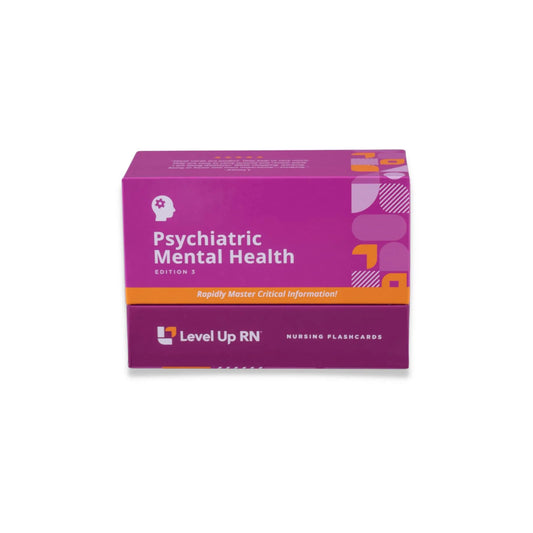In this article, we'll continue our discussion on abuse, including signs of different types of abuse and the nursing care of patients who have been abused. These topics are important to understand as part of your psychiatric mental health nursing education and practice.
If you missed it, check our previous article on aggression, violence, types of abuse, and abuse risk factors.
This series follows along with our Psychiatric Mental Health Nursing Flashcards which are intended to help RN and PN nursing students study for nursing school exams, including the ATI, HESI, and NCLEX.
Psychiatric Mental Health - Nursing Flashcards
Signs of abuse
There are different signs of abuse to look for depending on the type of abuse. Here, we'll explain the varying signs of abuse for physical abuse, emotional abuse, sexual abuse, and neglect.
Signs of physical abuse
Injury story inconsistency
If there is an inconsistency between the story of how an injury happened, and the injury itself, then that is suspect for abuse. For example, if a parent says, "My three-month-old crawled over to the stairs and fell down the stairs," that is highly unlikely because a three-month-old would not have reached the crawling stage yet. Infants usually begin to crawl between 8-10 months. You can learn more about the developmental stages of babies in our Pediatric Nursing Flashcards.
Multiple injuries
If you see multiple injuries in various stages of healing, that is also suspect for abuse, as are bruises on the cheeks, neck, genitals, buttocks, or back. Bruises in the shape of a causative object (e.g., a belt) are also a red flag.
Burns
Burns in the clear shape of a hot object (e.g., a cigarette burn) or forced-immersion burn patterns are also red flag signs of abuse. A forced-immersion burn would occur from someone having their hand dipped in something scalding.
Spiral fractures
Spiral fractures occur when a long bone (e.g., the femur, humerus) is broken by a twisting force, and the accidental causes of these are usually injuries from skiing, snowboarding, soccer, football, wrestling, or motorcycle accidents. A spiral fracture in a small child or infant is unlikely to be from these and can be a sign of abuse, like if the arm or leg was forcibly twisted.
Normal childhood bruises vs. Bruises as a result of abuse
Accidental bruises are often found on the extremities, like the elbows or knees, in children who are up and walking or running around. These are fairly common.
But bruises in unusual locations like the cheeks, neck, genitals, buttocks or back, are suspect for abuse.
Shaken baby syndrome
Signs and symptoms of shaken baby syndrome include poor feeding, irritability, lethargy, vomiting, seizures, periods of apnea, and retinal hemorrhage.
This is a serious form of abuse inflicted on a child, usually occurring when a parent or other caregiver shakes a baby out of anger or frustration.
Babies have very weak neck muscles, which is why you are supposed to support their head when you hold them. Shaking would cause the baby's head to move dangerously back and forth, which could cause brain injury and head trauma.
Signs of emotional abuse
Signs of emotional abuse can include extreme behavior, like if a child is overly compliant, overly demanding, extremely passive, or extremely aggressive.
Delayed physical and emotional development in a child may require additional assessment for emotional abuse.
Signs of sexual abuse
Signs of sexual abuse include difficulty walking or sitting, children that exhibit strange or advanced sexual behavior or understanding for their age, a child with sexually transmitted infections, frequent urinary tract infections, or new onset of bed-wetting.
Signs of neglect
Signs of neglect include if a child is frequently absent from school, begs for food or steals food or money, comes to school with unclean clothes, has body odor or poor dental health, or is dressed in a way that is inappropriate for the weather (e.g., wearing shorts in the middle of winter).
Nursing care for patients who have been abused
Assess the patient as soon as possible after the incident and provide immediate care for any physical injuries.
Clearly identify and count injuries. Take measurements, pictures, and full descriptions in the patient's record.
Interview the patient and caretaker separately. This can help identify story inconsistency as well.
Nurses are mandated reporters. Mandated reporters are required to report suspicion of abuse. You do not have to provide proof, you just have to provide the facts and circumstances that lead you to suspect abuse. The documentation that you do can be of assistance to the patient for legal purposes.
To learn more about mandatory reporting, check out our Fundamentals of Nursing Flashcards.
Help the patient develop a safety plan. You can provide information on shelters and safe houses as well as a plan for escape if abuse reoccurs.


